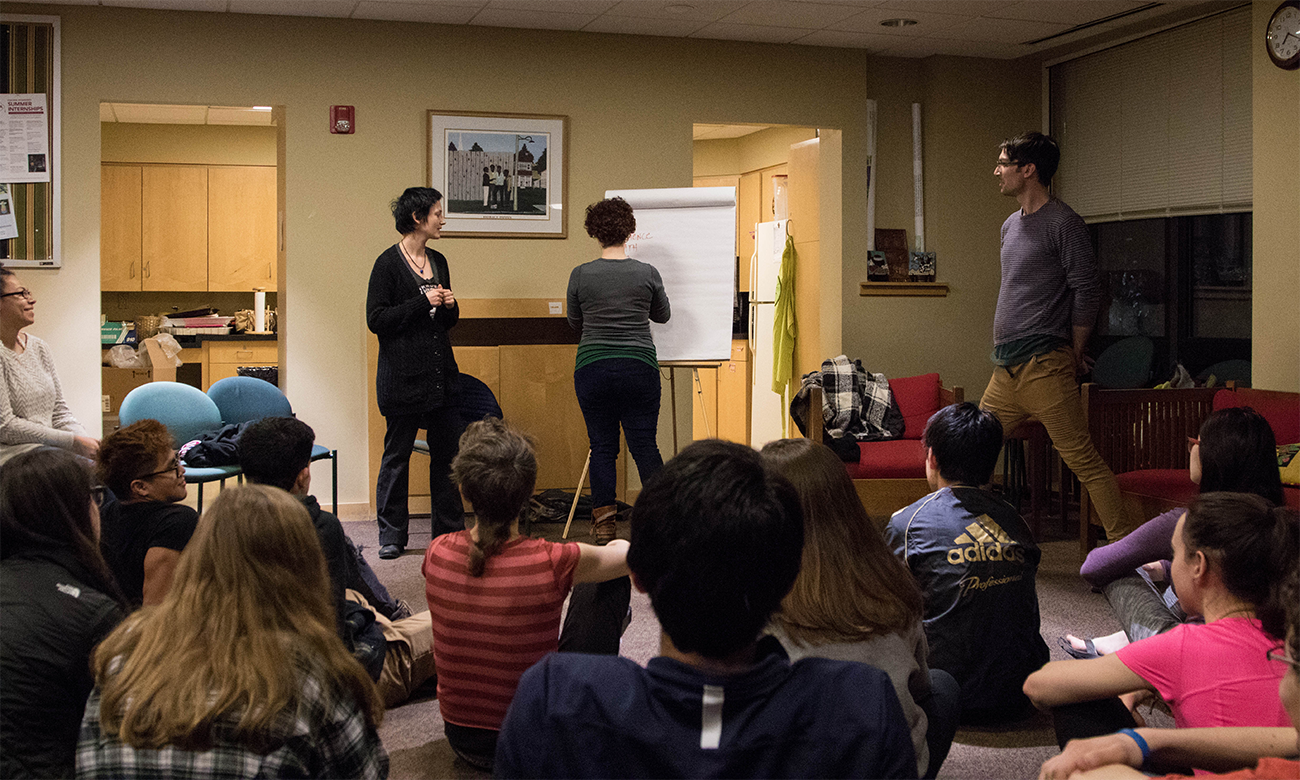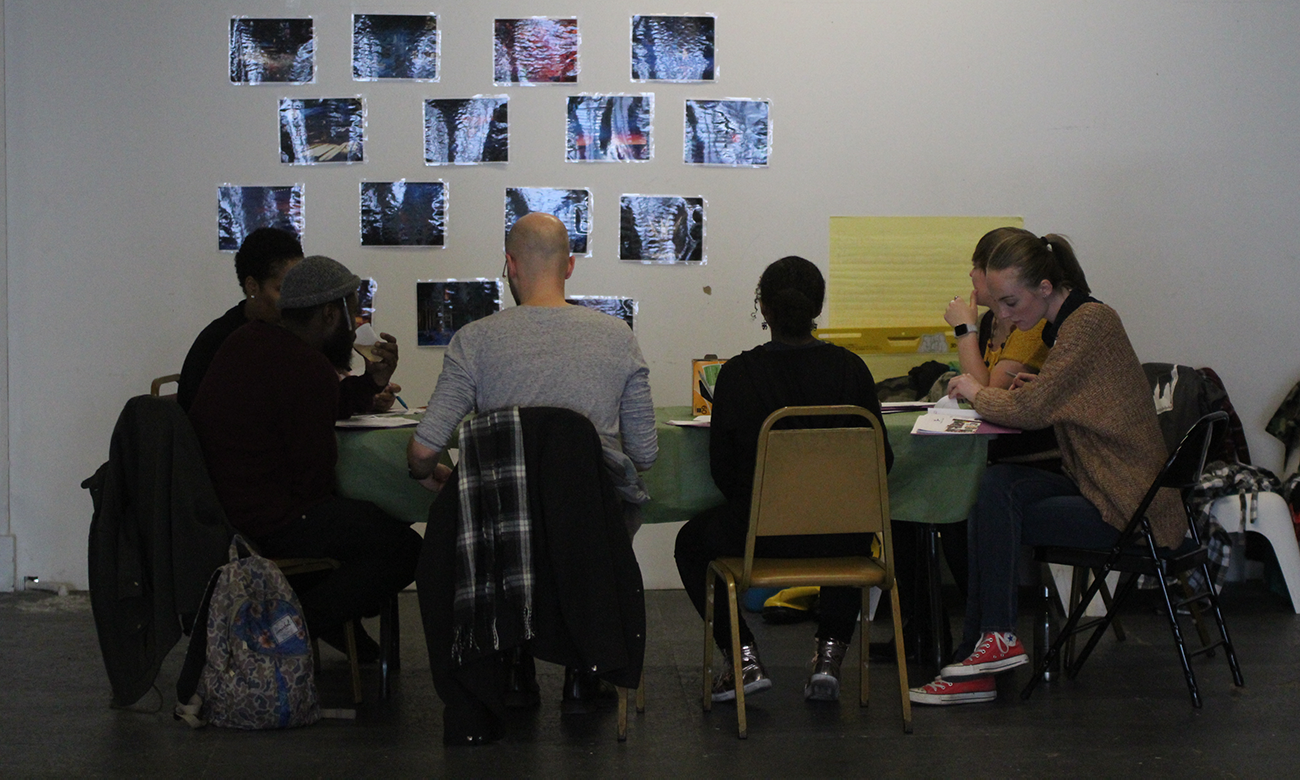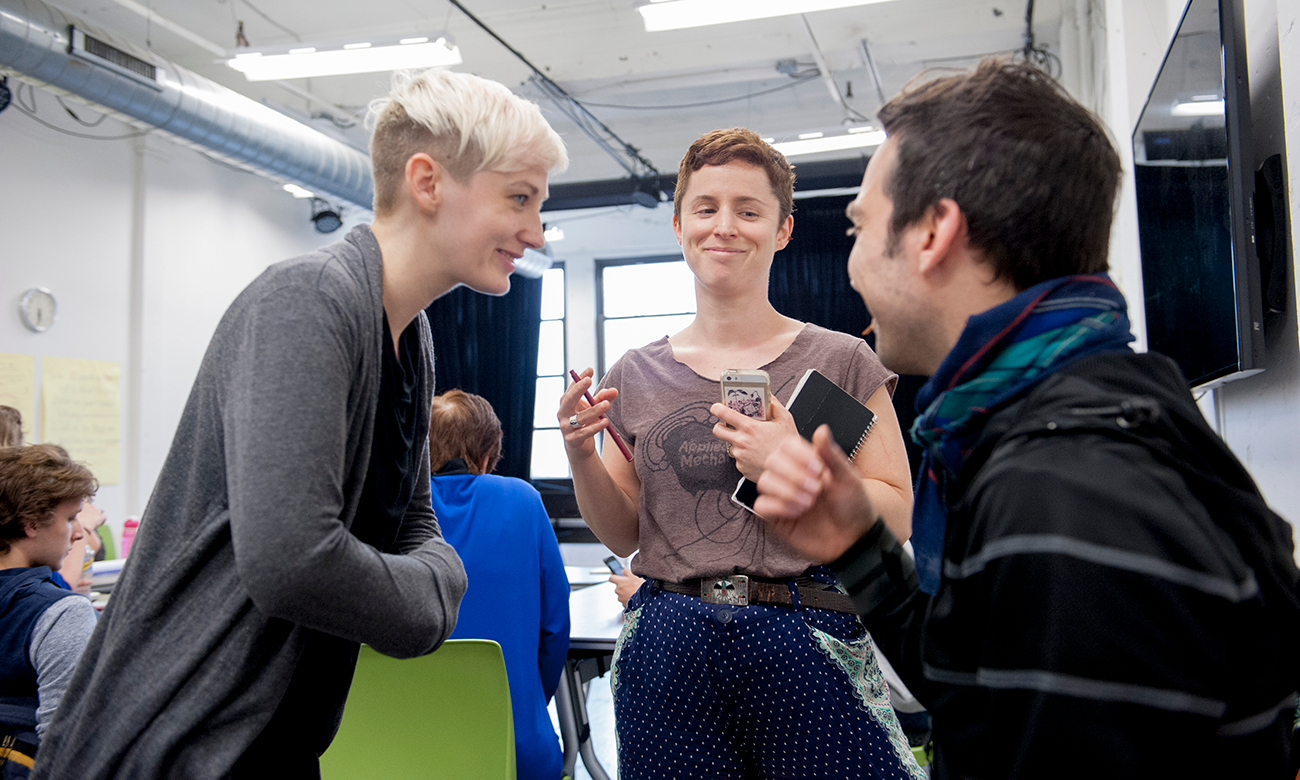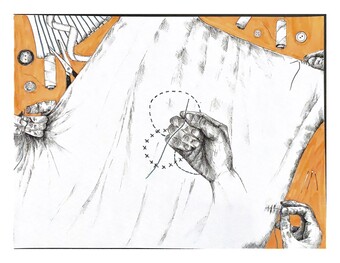Dismantling Hierarchies
The typical non-profit theatre model leans on a simple (and outdated) formula: There’s an artistic director, who is often the major determinant for the artistic shape of the institution. There’s a managing director, who keeps the administrative staff focused on their tasks, which are mostly isolated from the art itself. Then there’s the administrative staff and contract workers, who are almost always subject to the whims of upper management. I have been in too many rooms like these, where I was made to feel as if my voice didn’t matter or that the leadership viewed my contributions and perspective as secondary to theirs. I felt far too powerless, and I was hungry to learn from folks who were doing something different.
The Applied Mechanics collective operates under a socialist cooperative producing model, where leadership and labor is shared amongst the collective as a whole. Every member is paid the same amount, with the exception of an administrator who is paid more due to the position having a greater focus on labor rather than artistic collaboration.
Talking to Wright and Thomas Choinacky, another member of the group, led to some interesting reflections on what it means to give time to an institution or a collective. It felt significant that the company began as a group of working artists who were willing to work for free in the name of a shared vision and in a space where decisions about process, production, and planning are made democratically.
When hierarchy is eschewed in favor of unity, voices that aren’t normally heard suddenly come to light, forming an artistic process that allows for unique ideas. True consensus might be impossible under this model (the same for any others, for that matter), but the parties involved at least know their opinions and choices matter.
“If the ask is ‘I want everyone’s voice to be heard’ then you have to make a space where people want to contribute their voices,” says Wright. “The ‘everyone’s voice being heard’ thing, in addition to being a value, is also an aesthetic.”
Wright described Applied Mechanics’ immersive performances as being polyphonic: because many voices come together to mount the projects, the art that ensues can only be characterized as a collective vision, never the machinations of a single auteur.
Now more than ever, institutions must make a choice to either model a healthier professional culture or fade into irrelevance.
Thinking back to the rooms where I’ve felt the fraught anxiety, perhaps it was because the environment had very little to do with the art—that the progressive and even intersectional values shown in the productions were completely at odds with how leadership and administration behaved to their fellow professionals and freelancers.
When executive director Lisa Nelson-Hayes began her tenure at PYP in 2016, she noticed there was a very distinct line between the programmatic staff and the administrative staff. Her leadership style is highly collaborative, and she worked to eliminate the divide. “I’m always floored by how you never know where you’re going to get a fabulous idea,” she said.
The collaborative structure suddenly becomes one that benefits underrepresented artists who are used to finding a backdoor entrance to an institution.



















Comments
The article is just the start of the conversation—we want to know what you think about this subject, too! HowlRound is a space for knowledge-sharing, and we welcome spirited, thoughtful, and on-topic dialogue. Find our full comments policy here
Thanks, Carl(os). Since you're a Philly artist, you know PTC is undergoing a transformation and dying/growing pains. I look forward to more conversations and added both books that were cited to my reading.
Thanks for the article, Carl(os),
Our organization is trying to figure out how to flatten the corporate pyramid model so many of us non-profits have used for decades. The work culture you describe is really inspiring. I'm curious about the budget sizes of organizations who have done this with success. The question of eschewing punctuality and honoring a less rigid work practices sounds really attractive, but how does that work when you're in competition for resources to pay staff and artists (with families) a living wage etc.?
Hey Patrick, thanks so much for commenting! I think if you reach out to the folks at PYP and Applied Mechanics directly they can probably provide you with some better answers since I don't know too much about the specifics of their budget size or what they choose to prioritize. But what I can comment on are other details: PYP has a staff roster of around 10 administrators, and a roster of over 20 teaching artists. Applied Mechanics, on the other hand, operates with a group of 5-6 members (and maybe more depending on the scale of their projects) who share artistic and administrative labor. But in spite of the difference in scale, I believe what unites them as an organization is a sense of purpose that extends beyond producing 4-5 shows a season. The programming between both orgs is radically different in that regard: Applied Mechanics produces one show every year or so, and PYP's programming is entirely student-centered and engages an audience that consists of students, teachers, and families. It's important to note the differences between these two groups, and their intentions.
I think the idea that you can't balance the needs of your artists with the needs of the organization goes into this scarcity mentality that I'm talking about: it's one thing to think "how will we pay for XYZ?", but to ask deeper questions about your company's mission ("Why are we doing this work?", "Is this work still needed in 2019?", "Who is this work for?", "What kind of radical change do we need in order for our work to make an impact?") is an entirely different story. But of course, that's just speaking for my perspective - I'm sure folks at the other two orgs have some more tangible stuff to say.
So well put, thank you, Carl(os)!
Seconding Jax Gil's recommendation for Emergent Strategies, and adding David Bollier's writing on the commons (which was also recommended to me by Jamie Gahlon). The dynamics you articulate:
... that affect artists across all axes of oppression: The values of scarcity over abundance. The promotion of self over the celebration of others. The desperate grab for resources over the comfort of knowing there’s always enough for everyone. And, most importantly, micromanagement over trust...
remind me of the commons values championed by the Latinx Theatre Commons & HowlRound: non-hierarchical structure and abundance over scarcity thinking. It's threatening to power, but good for living...
Thanks so much for reading the article, Olga! I'm super excited for LTC's convening in Miami, and I'm looking forward to being there. And agreed! I think devised theatre processes, in particular, have taught me a lot about what it means to share power. When everyone in the room is contributing ideas - as opposed to working around someone else's idea - the possibilities that can come from that are so much greater.
Re: abundance vs. scarcity - sometimes these attitudes can be so pervasive that I have to recognize them in myself and in others as well. I often find that if the instinct is to find all the reasons why something can't happen, that it leads to a very unhealthy space. I've been watching a lot of bell hooks videos lately and she talks about how we are not only limiting ourselves as people, but we're also limiting our own imaginations: as if our dreams of a healthier culture is something that exists outside of ourselves, rather than some that exists within. It's been a thought that has stayed with me for some time now, and nowadays I'm always trying to find affirming spaces rather than insistent ones.
Thank you for this beautiful, necessary piece.
I especially resonated with:
...PYP is an organism that’s alive, that morphs and that’s reactive towards whatever forces they’re faced with. “I want us to constantly be proactive and progressive in our thoughts,” she says. “How we are functioning internally will be reflected in how we function with the constituents we serve."
The organic makeup of a staff directory needs to mirror the very people they’re intended to benefit. In this vein, ideas are more important than institutions, and, above all else, people are more important than ideas.
This reminds me of the fractal chapter in adrienne maree brown's Emergent Strategy. She writes that how we are at the smallest scale is how we are at all the larger scales. I also love the celebration of individual work styles, including different relationships to labor itself - a timely conversation as we grapple with the devastating effects of late stage capitalism.
You're the third person to mention Emergent Strategy in the past month, so I definitely need to put that at the top of my reading list. For me, a big inspirational text was The Revolution Will Not Be Funded, which talks a lot about how workers are affected by the non-profit industrial complex. Thanks so much for reading the article!